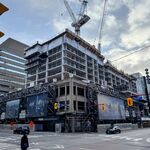unrealestate
Active Member
having a section above ground and not grade separated was such an idiotic decisionThe line runs automated in its grade-separated right-of-way underground/elevated (Automatic Train Operation or ATO), and once it emerges at Laird, it switches to manual control since it runs on street (Automatic Train Protection or ATP). Transitioning between the two systems on one line mid-service I believe is somewhat unconventional and is probably behind some of the headaches.




